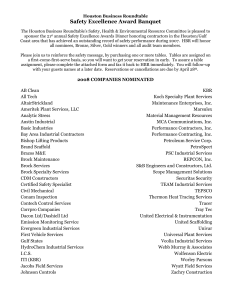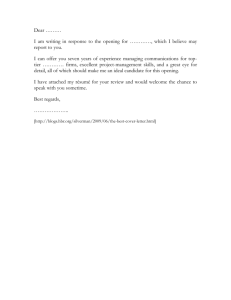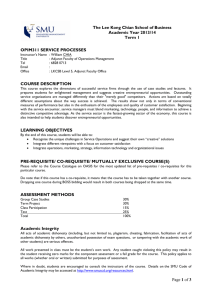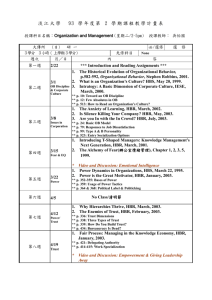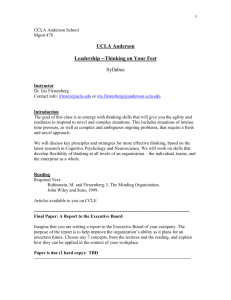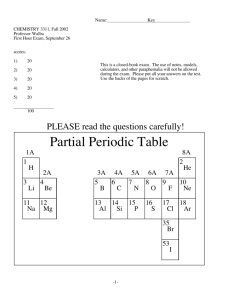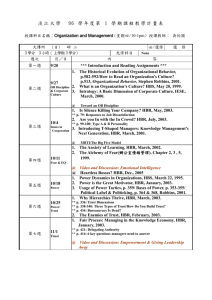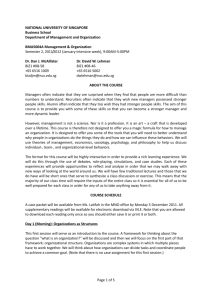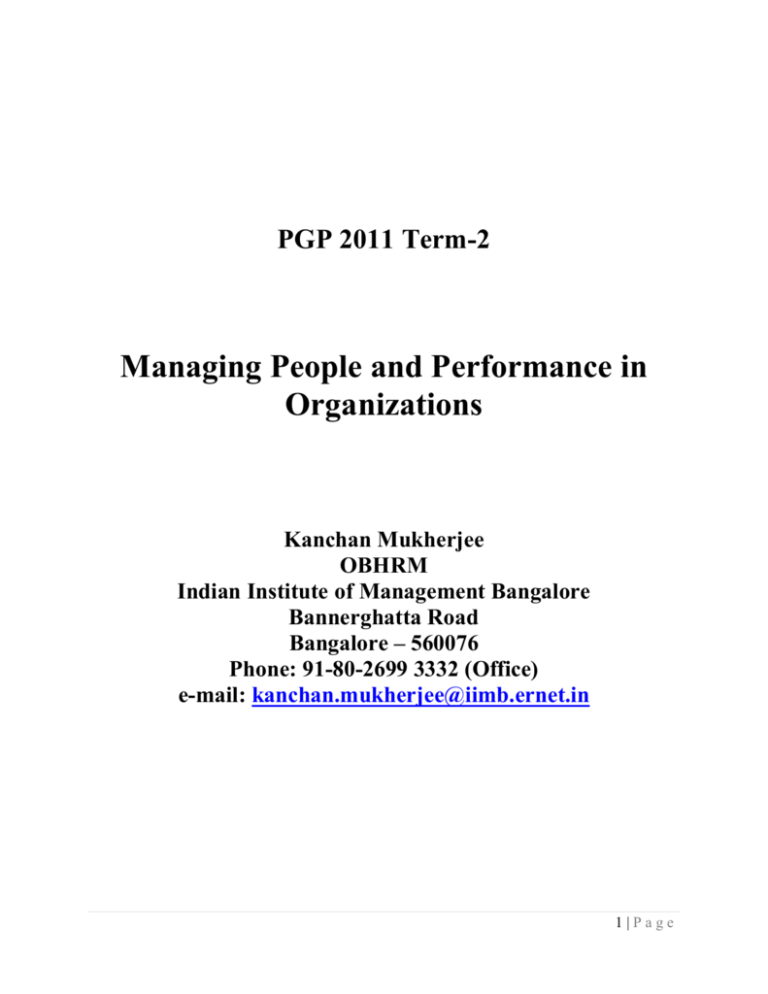
PGP 2011 Term-2
Managing People and Performance in
Organizations
Kanchan Mukherjee
OBHRM
Indian Institute of Management Bangalore
Bannerghatta Road
Bangalore – 560076
Phone: 91-80-2699 3332 (Office)
e-mail: kanchan.mukherjee@iimb.ernet.in
1|Page
Indian Institute of Management Bangalore
PGP 2011, Sections C & D
Managing People and Performance in Organizations
Faculty: Kanchan Mukherjee
Office: A-205A; Phone: 2699 3332 (off)
Objectives of the Course
•
Provide participants with an enhanced understanding of theory related to individual and
group behavior in organizations
•
Facilitate the development of a meaningful perspective to understand, diagnose, predict,
influence and effectively deal with the issues of human behavior in organisations.
•
Enable the participants to appreciate the role of human resource systems and the manner
in which they align with the objectives of the organization
•
To develop deeper insights into one’s own behavior in Interpersonal, Group and Team
settings and reflect on your roles as people managers.
Evaluation
1.
3.
4.
Group project
In class quizzes
Class participation/presentation
40%
50%
10%
Reading material
•
•
Text book: Organizational Behaviour by Stephen P. Robbins, Timothy A. Judge and Seema
Sanghi; 14th Edition, Pearson Prentice Hall.
Questionnaires, psychological instruments and supplementary readings are provided in the
course pack. Additional readings may be provided during the course.
2|Page
Course Outline with Readings
I. Introduction
1. Robbins et al. Chapter 1
2. Rynes, S. L., Brown, K. G. ,Colbert, A. E. (2002). Seven common misconceptions about
human resource practices: Research findings versus practitioner beliefs. Academy of
Management Executive, 16, 92-102.
II. The Individual in Organizations
1. Human Perception & Attribution
Robbins et al. Chapter 5
2. Personality, Values and Attitudes
a) Robbins et al. Chapter 4
b) Judge, T. A., Klinger, R., Simon, L. S. and Yang, F. I.W. (2008) The contributions of
personality to organizational behavior and psychology: Findings, criticisms, and
future research directions. Social and Personality Psychology Compass, 2, 1982–
2000.
c) Patel, T. (2006). Comparing the usefulness of conventional and recent personality
assessment tools: Playing the right music with the wrong instrument. Global Business
Review, 195-218
d) Harry Levinson (1978). The abrasive personality. HBR.
e) Patrick M. Lencioni (2002). Make your values mean something. HBR.
Exercises:
Personality Inventories: MBTI/Big-5
3. Decision Making
a) Gardiner Morse (2006). Decisions and desire. HBR.
b) Dan Lovallo & Daniel Kahneman (2003). Delusions of success. HBR.
c) Milkman, K. L., Rogers, T, & Bazerman, M.H. (2010) Harnessing Our Inner Angels
and Demons, Perspectives on Psychological Science.
3|Page
III. Managing Performance in Organizations
1. Motivation
a) Robbins et al. Chapters 6, 7
b) Nohria, N, Boris G, & Linda-Eling L. (July - August 2008): "Employee Motivation:
A Powerful New Model." HBS Centennial Issue. HBR.
c) Herzberg, H. (2003). One more time: How do you motivate employees? HBR special
issue.
d) Livingston, J.S. (1988). Pygmalion in management. HBR.
2. Compensation, Rewards and Retention
a) Robbins et al.Chapter 7
b) Butler Timothy & James Waldroop (1999). Job sculpting: The art of retaining your
best people. HBR.
c) Kerr, S. (1995). On the folly of rewarding A, while hoping for B. Academy of
Management Executive.
3. Recruitment, Training and Development
a) Chapter-3 of Kalliath Borough, O’Driscoll, Manimala and Siu, Organizational
Behavior - A Psychological Perspective for the Asia-Pacific, McGraw-Hill, Australia
2010.
b) Fernandez-Araoz, C., Groysberg, B., Nohria, N. ( 2009). The definitive guide to
recruiting in good times and bad. HBR.
c) Saks, A. M. & Haccoun, R.R. (2010). Managing performance through training and
development. Nelson Education Series in Human Resource Management (5th Ed).
4. Performance Management and Appraisal Systems
Chapters 32 – 34. Handbook of Human Resource Management Practice (10th Ed).
Michael Armstrong.
5. Principal-Agent Model
6. Work Stress and Career Management
Guest speaker.
4|Page
IV. Organizations as Social Systems
1. Frameworks for Understanding the Interpersonal World
Exercises:
a) JOHARI Window (Personal Style Effectiveness)
b) FIRO-B
2. Groups and Teams
a)
b)
c)
d)
Robbins et al. Chapters 9, 10
Katzenbach J & Smith (2005) The Discipline of Teams. HBR.
Gratton, L., Erickson T. J. (2007) Ways to build collaborative teams. HBR
Choi ,J.N. & Kim, M.U. (1999). The Organizational applications of groupthink
and its limits in organizations. Journal of Applied Psychology, 297-306.
3. Negotiation
a) Robbins et al. Chapter 15
b) Deepak Malhotra & Max H. Bazerman (2007). Investigative negotiation. HBR.
c) Jeff Weiss & Jonathan Hughes (2005). Want collaboration? Accept – and actively
manage – conflict. HBR.
d) Negotiation game.
4. Social Influence, Power and Politics
a) Robbins et al. Chapter 14
b) Chapter 6. Social Influence: Conformity, Compliance, and Obedience in Douglas
T.Kenrick, Steven L. Neuberg, & Robert B.Cialidini (Eds.) Social Psychology:
Unraveling the Mystery.
c) Cialdini, R.B. (Oct., 2001). Harnessing the science of persuasion. HBR.
5. Leadership
a) Robbins et al. Chapter 12, 13
b) Goleman, Daniel (2004).What makes a leader? HBR.
c) Collins, Jim (year) (2005). Level 5 leadership. HBR.
V. Group Project Presentations
5|Page

